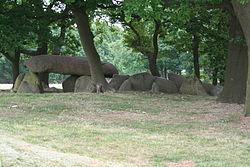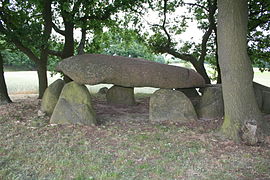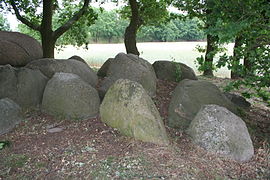Stöckheim stone grave
| Stöckheim stone grave | ||
|---|---|---|
|
The Stöckheim stone grave, view from the east |
||
|
|
||
| Coordinates | 52 ° 42 '16.4 " N , 10 ° 59' 32.6" E | |
| place | Rohrberg (Altmark) , Saxony-Anhalt , Germany | |
| Emergence | 3700 to 3350 BC Chr. | |
The Stöckheim large stone grave is a megalithic grave complex of the Neolithic deep-engraved ceramic culture in the municipality of Rohrberg , district of Stöckheim in the Altmark district of Salzwedel , Saxony-Anhalt .
location
The plant is located just after the southern exit of Stöckheim, east of the road to Lüdelsen in a field. It is surrounded by a small group of trees and can be reached via a dirt road.
1.8 km to the west-southwest are the megalithic graves near Lüdelsen . Other large stone graves that were destroyed were located southwest near Nieps , southeast near Ahlum and east near Rohrberg .
Research history
The grave was first described by Johann Friedrich Danneil in 1843 . In 1883 it was visited by Hermann Dietrichs and Ludolf Parisius , along with a few other large stone graves , who published a report on it. In the 1890s, Eduard Krause and Otto Schoetensack carried out a new survey of the great stone graves of the Altmark. Since 1972 the grave has been cleaned and freed from vegetation annually by the association “Young Archaeologists of the Altmark”. In 2003-04, a further recording and measurement of all the still existing large stone graves in the Altmark took place as a joint project of the State Office for Monument Preservation and Archeology of Saxony-Anhalt , the Johann Friedrich Danneil Museum in Salzwedel and the association “Young Archaeologists of the Altmark”.
description
The system belongs to the large dolmen type . It is located on a flat meridional hill and originally consisted of 16 bearing stones and four cap stones, which formed a north-south oriented chamber, which is completely preserved except for two bearing stones. The edging stones of the hill are no longer there. Two bearing stones fell over, the three southern cap stones fell. The northern capstone, which is the largest surviving capstone of all large stone graves in the Altmark, is still in situ . It is 4.5 m long, 2.9 m wide, 0.8 m thick and weighs about 22 tons. At its southwest corner it has a deep groove (referred to by lay people as a blood groove). Over 80 bowls have been worked into its surface .
The chamber has a trapezoidal floor plan and measures 9.2 m in north-south direction and between 1.8 and 2.2 m in east-west direction. Their height is around one meter. It increases to the north. The chamber can be reached via a corridor. This consists of two small bearing stones and a cap stone that has slipped today. The corridor is 0.8 m wide and 0.4 m high.
The Stöckheim large stone grave in regional legends
There are some popular legends about the Stöckheim large stone grave . One sees it as the tomb of the biblical giant Goliath . He could no longer stand it in the holy land , because he was mocked there because of his defeat against the shepherd boy David . He decided to look for a new resting place and found a suitable place in Stöckheim. There he first set up a few stones and then turned back to fetch his golden coffin and tombstone. He took the coffin under his arm and tied the tombstone to his back with a gold chain. However, this chafed while walking and thus formed the distinctive channel on the northern capstone. The legend also finds an explanation for the bowls: These arise because Goliath climbs out of his grave every New Year's night and scrapes three holes in the stone that are as big as the wound that David's slingshot once inflicted on him.
Another legend tells of underground people who often stay in the burial chamber and kidnap children. The legend tells of a manager of the manor of Ahlum , who did not care about these things and did not warn his daughter to be careful. The good-looking and healthy daughter was then exchanged by the underground for an ugly, insane girl who died at the age of 18. The underground should also leave the burial chamber more often to go bowling on the so-called Mühlenstein at the Ahlumer Mühle. This stone was removed in 1901 and used as building material.
See also
literature
- Hans-Jürgen Beier : The megalithic, submegalithic and pseudomegalithic buildings and the menhirs between the Baltic Sea and the Thuringian Forest (= contributions to the prehistory and early history of Central Europe. Volume 1). Wilkau-Haßlau 1991, p. 53.
- Wilhelm Blasius : Guide to the megalithic grave monuments in the western part of the Salzwedel district. In: Thirty-first annual report of the Altmark Association for Patriotic History and Industry. Issue 2, 1904, pp. 103-104 ( PDF; 8.1 MB ).
- Hartmut Bock , Barbara Fritsch, Lothar Mittag: Great stone graves of the Altmark . State Office for Monument Preservation and Archeology Saxony-Anhalt and State Museum for Prehistory, Halle (Saale) 2006, ISBN 3-939414-03-4 , pp. 152–158, 192–199.
- Johann Friedrich Danneil : Special evidence of the barrows in the Altmark . In: Sixth annual report of the Altmark Association for Patriotic History and Industry . 1843, p. 110 ( PDF; 5.5 MB ).
- Hermann Dietrichs , Ludolf Parisius : Pictures from the Altmark. First and second volume. Hamburg 1883, p. 274 ( online ).
- Barbara Fritsch : Stöckheim, Ldkr. Altmarkkreis Salzwedel. In: Siegfried Fröhlich (Ed.): From the prehistory of Saxony-Anhalt. State Museum for Prehistory Halle (Saale), Halle (Saale) 1995, ISBN 3-910010-13-X , No. 14.
- Hans-Ulrich Kelch: Mysterious pans. In: Hartmut Bock (Ed.): Cities - Villages - Friedhöfe. Archeology in the Altmark 2: From the High Middle Ages to the modern age (= contributions to the cultural history of the Altmark and its peripheral areas, Volume 8). Oschersleben 2002, ISBN 3-935358-36-9 , pp. 458-469.
- Eduard Krause , Otto Schoetensack : The megalithic graves (stone chamber graves) of Germany . I .: Altmark . In: Journal of Ethnology . Vol. 25, 1893, p. 152 / no. 130, Plates VI / 130, VII / 130, IX / 130 ( PDF; 39.0 MB ).
- Teachers' Association of the Altmark (ed.): Altmärkischer Sagenschatz. Leipzig / Berlin 1908, pp. 144–145.
- Lothar Mittag: barrows, special stones and stone crosses in the legendary world of Altmark . Johann-Friedrich-Danneil-Museum Salzwedel, Salzwedel 2005, pp. 25–27.
- Detlef W. Müller : Stöckheim. In: Joachim Herrmann (Hrsg.): Archeology in the German Democratic Republic. Monuments and finds. Volume 2, Urania, Leipzig / Jena / Berlin 1989, ISBN 3-332-00308-9 , p. 406.
- Alfred Pohlmann : Legends from the cradle of Prussia and the German Empire, the Altmark. Franzen & Große, Stendal 1901, pp. 87-88.
- Britta Schulze-Thulin : Large stone graves and menhirs. Saxony-Anhalt • Thuringia • Saxony . Mitteldeutscher Verlag, Halle (Saale) 2007, ISBN 978-3-89812-428-7 , p. 45.
Web links
- The Megalithic Portal: Stoeckheim Steingrab
- grosssteingraeber.de: The Stöckheim large stone grave near Salzwedel
- tw.strahl.org: "Stöckheim" stone grave , Stöckheim, southwest of Salzwedel, Altmark
- www.museen-altmarkkreis.de
Individual evidence
- ↑ Hartmut Bock: Student working groups and ground monument preservation in the north-western Altmark. In: Annual publication for Central German prehistory. Volume 69, 1986, p. 285 ( online ).
- ^ Young archaeologists of the Altmark eV - On the history of the association .
- ↑ Hartmut Bock, Barbara Fritsch, Lothar Mittag: Großsteingraves der Altmark. 2006, p. 11.
- ↑ Hartmut Bock, Barbara Fritsch, Lothar Mittag: Großsteingraves der Altmark. 2006, p. 152
- ↑ Hartmut Bock, Barbara Fritsch, Lothar Mittag: Großsteingraves der Altmark. 2006, p. 154; Mittag, pp. 26-27
- ↑ Hartmut Bock, Barbara Fritsch, Lothar Mittag: Großsteingraves der Altmark. 2006, p. 158; Mittag, pp. 26-27







